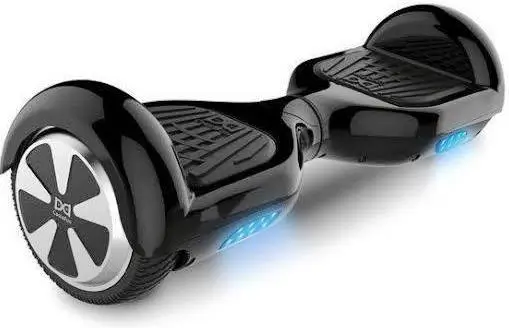How does Self balancing Scooter work?
Self-balancing scooters, also known as hoverboards, use a combination of sensors, motors, and control systems to maintain balance and move forward or backward. Here’s how they work:
Sensors
Self-balancing scooters use gyroscopic sensors to detect changes in the rider’s center of gravity and adjust the speed of the motors accordingly. There are usually two sensors, one for each footpad, which work together to maintain balance.
Motors
The self-balancing scooter has two motors, one for each wheel, which can be controlled independently. When the rider leans forward, the motors spin faster to move the scooter forward; when the rider leans backward, the motors slow down to move the scooter backward.
Control system
The control system is responsible for processing the sensor data and controlling the motors to maintain balance. It uses algorithms to calculate the appropriate speed and direction for the motors based on the rider’s movements.
Battery
The self-balancing scooter is powered by a rechargeable battery, which provides the energy needed to run the motors and control system.
When a rider steps onto a self-balancing scooter, the sensors detect the change in center of gravity and the control system activates the motors to maintain balance. As the rider leans forward or backward, the sensors detect the movement and adjust the speed of the motors to move the scooter in the desired direction.
To turn, the rider simply shifts their weight to the left or right, which causes the sensors to detect the change in center of gravity and the control system to adjust the speed of the motors accordingly.
In summary, self-balancing scooters use sensors, motors, and a control system to maintain balance and move in the desired direction based on the rider’s movements. They are powered by a rechargeable battery and are a popular mode of transportation for short distances.
सेल्फ बैलेंसिंग स्कूटर कैसे काम करता है?
सेल्फ-बैलेंसिंग स्कूटर, जिन्हें होवरबोर्ड के रूप में भी जाना जाता है, संतुलन बनाए रखने और आगे या पीछे जाने के लिए सेंसर, मोटर और नियंत्रण प्रणालियों के संयोजन का उपयोग करते हैं। यहां बताया गया है कि वे कैसे काम करते हैं:
सेंसर
सेल्फ-बैलेंसिंग स्कूटर सवार के गुरुत्वाकर्षण के केंद्र में परिवर्तन का पता लगाने और उसके अनुसार मोटर की गति को समायोजित करने के लिए जाइरोस्कोपिक सेंसर का उपयोग करते हैं। आमतौर पर दो सेंसर होते हैं, प्रत्येक फ़ुटपैड के लिए एक, जो संतुलन बनाए रखने के लिए एक साथ काम करते हैं।
मोटर्स
सेल्फ-बैलेंसिंग स्कूटर में दो मोटर हैं, प्रत्येक पहिये के लिए एक, जिसे स्वतंत्र रूप से नियंत्रित किया जा सकता है। जब सवार आगे की ओर झुकता है, तो स्कूटर को आगे बढ़ाने के लिए मोटरें तेजी से घूमती हैं; जब सवार पीछे की ओर झुकता है, तो स्कूटर को पीछे की ओर ले जाने के लिए मोटरें धीमी हो जाती हैं।
नियंत्रण प्रणाली
नियंत्रण प्रणाली सेंसर डेटा को संसाधित करने और संतुलन बनाए रखने के लिए मोटरों को नियंत्रित करने के लिए जिम्मेदार है। यह सवार की गतिविधियों के आधार पर मोटरों के लिए उचित गति और दिशा की गणना करने के लिए एल्गोरिदम का उपयोग करता है।
बैटरी
सेल्फ-बैलेंसिंग स्कूटर एक रिचार्जेबल बैटरी द्वारा संचालित होता है, जो मोटर और नियंत्रण प्रणाली को चलाने के लिए आवश्यक ऊर्जा प्रदान करता है।
जब एक सवार स्व-संतुलन वाले स्कूटर पर कदम रखता है, तो सेंसर गुरुत्वाकर्षण के केंद्र में परिवर्तन का पता लगाते हैं और नियंत्रण प्रणाली संतुलन बनाए रखने के लिए मोटरों को सक्रिय करती है। जैसे ही सवार आगे या पीछे झुकता है, सेंसर गति का पता लगाते हैं और स्कूटर को वांछित दिशा में ले जाने के लिए मोटरों की गति को समायोजित करते हैं।
मुड़ने के लिए, सवार बस अपना वजन बाईं या दाईं ओर बदलता है, जिससे सेंसर गुरुत्वाकर्षण के केंद्र में परिवर्तन का पता लगाता है और नियंत्रण प्रणाली मोटर की गति को तदनुसार समायोजित करती है।
संक्षेप में, सेल्फ-बैलेंसिंग स्कूटर संतुलन बनाए रखने और सवार की गतिविधियों के आधार पर वांछित दिशा में आगे बढ़ने के लिए सेंसर, मोटर और एक नियंत्रण प्रणाली का उपयोग करते हैं। वे रिचार्जेबल बैटरी द्वारा संचालित होते हैं और कम दूरी के लिए परिवहन का एक लोकप्रिय साधन हैं।




